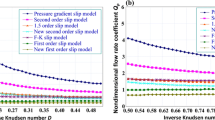Abstract
This paper investigates the effect of discrete tracks on the steady state flying behavior of sub ambient proximity sliders. A finite element based air bearing simulator is used to simulate the flying characteristics of sliders over a grooved disk surface. Sliders flying over discrete track disks “see” a disk surface that consists of ridges and grooves. The air bearing pressure build-up for sliders flying over discrete track disks is different from that for sliders flying over plane disks. Low air bearing pressure can be expected for those regions of the slider that are positioned over grooves, while high air bearing pressure exists over ridges. The air bearing characteristics are determined for several pico and femto-type air bearing sliders flying over discrete track disks. An empirical equation is obtained describing the loss of flying height of a slider flying over discrete track disks.











Similar content being viewed by others
References
Bertram N, Williams M (2000) SNR and density limit estimates: a comparison of longitudinal and perpendicular recording. IEEE Trans Magn 36(1):4–9
Buscaglia G, Jai M (2004) Homogenization of the generalized reynolds equation for ultra-thin gas films and its resolution by FEM. ASME J Tribol 126:547–552
Duwensee M, Suzuki S, Lin J, Wachenschwanz D, Talke F (2006) Air bearing simulation of discrete track recording media, IEEE Trans Magn (in print)
Fukui S, Kaneko R (1988a) Analysis of ultra-thin gas film lubrication based on linearized Boltzmann equation: first report-derivation of a generalized lubrication equation including thermal creep flow. ASME J Tribol 110:253–262
Fukui S, Kaneko R (1988b) Analysis of flying characteristics of magnetic heads with ultra-thin spacings based on the Boltzmann equation. IEEE Trans Magn 24(6):2751–2753
Gross WA (1959) A gas film lubrication study, Part I, some theoretical analyses of slider bearings. IBM J Res Dev 3:237–255
Horton B (2004) Magnetic head flyability on patterned media, Thesis, Georgia Institute of Technology
Kryder MH (2003) Future trends in magnetic storage technology, Joint NAPMRC 2003. Digest of technical papers (perpendicular magnetic recording conference), 6–8 January p 68
Michael WA (1959) A gas film lubrication study, Part II, numerical solution of the finite slider bearings. IBM J Res Dev 3:256–259
Reynolds O (1886) On the theory of lubrication and its applications to mr. beauchamp tower’s experiments including an experimental determination of the viscosity of olive oil. Philos Trans R Soc Ser A 12:157–234
Soeno Y, Moriya M, et al (2003) Feasibility of discrete track perpendicular media for high track density recording. IEEE Trans Magn 39(1):1967–1971
Soeno Y, Moriya M, Kaizu A, Takai M (2005) Performance evaluation of discrete track perpendicular media for high recording density. IEEE Trans Magn 41(10):3220–3222
Tagawa N, Bogy D (2002) Air film dynamics for micro-textured flying head slider bearings in magnetic hard disk drives. ASME J Tribol 124:568–574
Tagawa N, Mori A (2003) Thin film gas lubrication characteristics of flying head slider bearings over patterned media in hard disk drives. Microsyst Technol 9:362–368
Tagawa N, Hayashi T, Mori A (2001) Effects of moving three-dimensional nano-textured disk surfaces on thin film gas lubrication characteristics for flying head slider bearings in magnetic storage. ASME J Tribol 123:151–158
Wachenschwanz D, Jiang W, Roddick E, et al (2005) Design of a manufacturable discrete track recording medium. IEEE Trans Magn 41(2):670–675
Wahl M, Lee P, Talke F (1996) An efficient finite element-based air bearing simulator for pivoted slider bearings using bi-conjugate gradient algorithms, STLE Tribol Trans 39(1)
Weissner S, Tonder K, Talke F (1998), Surface roughness effects in compressible lubrication. In: Proceedings of AUSTRIB 1998, Brisbane
Zhang J, Su L, Talke F (2005) Effect of surface texture on the flying characteristics of pico sliders. IEEE Trans Magn 41(10):3022–3024
Acknowledgments
We would like to acknowledge the interest and cooperation of Komag, Inc., in this study. This research was partially supported by a grant from the Information Storage Industry Consortium (INSIC).
Author information
Authors and Affiliations
Corresponding author
Rights and permissions
About this article
Cite this article
Duwensee, M., Suzuki, S., Lin, J. et al. Simulation of the head disk interface for discrete track media. Microsyst Technol 13, 1023–1030 (2007). https://doi.org/10.1007/s00542-006-0314-9
Received:
Accepted:
Published:
Issue Date:
DOI: https://doi.org/10.1007/s00542-006-0314-9




